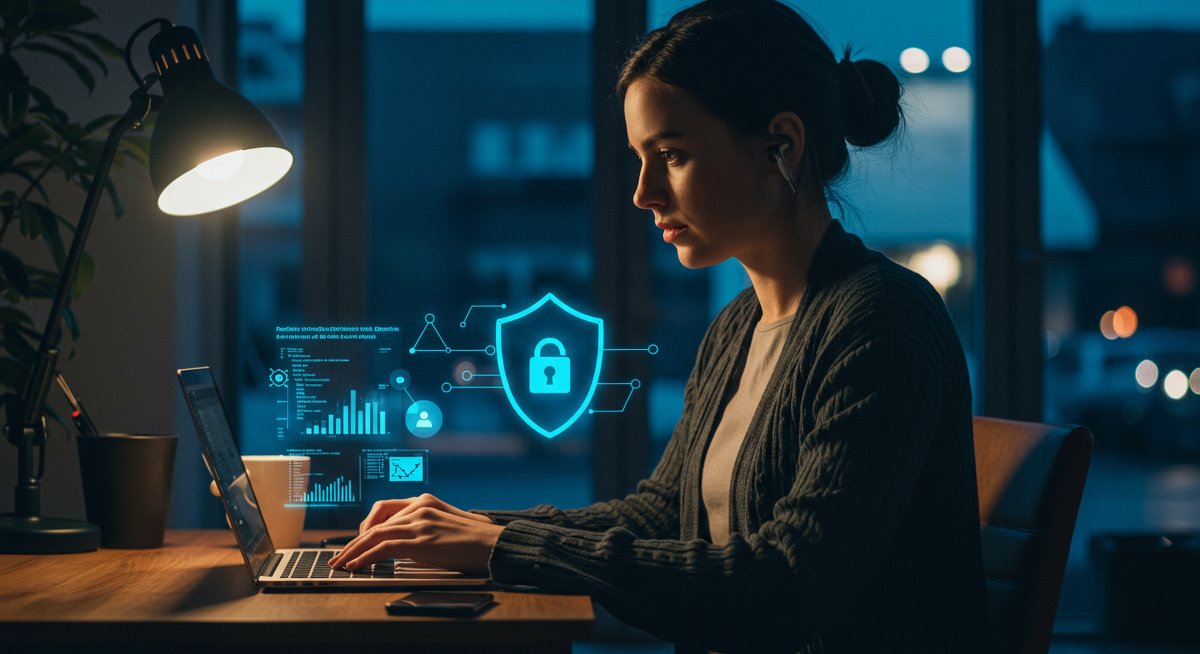Embarking on a digital nomad journey is an exciting prospect, promising freedom and adventure. However, with this lifestyle comes the responsibility of safeguarding your digital life. Cyber threats are pervasive, and as a digital nomad, you're a prime target. Public Wi-Fi, unsecured devices, and the constant movement between locations create vulnerabilities. This guide offers practical cybersecurity strategies tailored for aspiring digital nomads, ensuring you can explore the world with confidence and security. We'll cover essential steps to protect your data, devices, and remote work setup, providing you with the knowledge and tools to stay safe online.

Why Embracing Cybersecurity Matters for Your Nomad Journey
As a digital nomad, your entire livelihood often depends on your online presence and access to the internet. Your laptop, smartphone, and other devices are not just tools for work; they're also repositories of personal and financial information. A security breach can result in identity theft, loss of funds, damage to your reputation, and disruption to your work. The risks are amplified by the nature of the nomad lifestyle: frequent use of public Wi-Fi, reliance on mobile devices, and the potential for physical theft or loss.
Consider this: you're working from a bustling cafe in Bali, connected to their free Wi-Fi. Unbeknownst to you, a hacker is monitoring the network, intercepting your data. Suddenly, your online accounts are compromised, and your sensitive information is exposed. Or, imagine your laptop is stolen at a co-working space in Barcelona. If you haven't taken the necessary precautions, the thief gains access to all your data. These scenarios underscore the critical need for robust cybersecurity measures.
Example 1: Sarah, a freelance writer, didn't use a VPN while working from various cafes. Her unencrypted login details for her bank account were intercepted, resulting in unauthorized transactions. The financial loss, combined with the stress of resolving the issue, severely impacted her nomadic lifestyle.
Example 2: John, a web developer, had his laptop stolen while traveling in Thailand. Because he failed to encrypt his hard drive, the thief was able to access client projects and personal data, leading to a major breach of trust with his clients and potential legal ramifications.
Expert Tip: Regularly update all software, including your operating system, web browser, and applications. These updates often include critical security patches that address known vulnerabilities. Make it a habit, and automate where possible.
Essential First Steps to Become a Digital Nomad
Before you even book your first flight, establishing a strong cybersecurity foundation is crucial. Here are the essential first steps to take:
Choose Strong, Unique Passwords: Avoid using the same password across multiple accounts. Use a password manager to generate and store complex, unique passwords. Consider using a passphrase – a long, memorable phrase – instead of a single word.
Enable Two-Factor Authentication (2FA): Whenever possible, enable 2FA on all your important accounts (email, banking, social media, etc.). This adds an extra layer of security by requiring a second verification method, such as a code sent to your phone, in addition to your password.
- Example: If someone gets your password, they still won't be able to access your account without the 2FA code from your phone.
Secure Your Devices: Install reputable antivirus software on all your devices (laptop, smartphone, tablet). Keep your operating systems and software up to date. Enable automatic updates to ensure you're always protected against the latest threats.
Back Up Your Data: Regularly back up your data to a secure cloud storage service or an external hard drive. Consider using an encrypted cloud storage solution for added security.
Learn the Basics of Phishing: Be aware of phishing scams that attempt to steal your credentials or install malware. Never click on suspicious links or provide personal information to untrusted sources.
Common Beginner Challenges & How to Overcome Them
Starting your digital nomad journey can be overwhelming, and cyber threats can add to the stress. Here are some common challenges and how to address them:
Challenge 1: Public Wi-Fi Risks: Public Wi-Fi networks are often unencrypted and vulnerable to eavesdropping. Hackers can easily intercept your data transmitted over these networks.
- Solution: Always use a VPN (Virtual Private Network) when connecting to public Wi-Fi. A VPN encrypts your internet traffic, making it unreadable to potential eavesdroppers. Consider using a VPN like NordVPN or ExpressVPN.
Challenge 2: Device Theft/Loss: Losing your laptop or smartphone can be devastating, especially if it contains sensitive data.
- Solution: Encrypt your hard drive, so even if someone gains physical access to your device, they can't read your data. Use a device tracking app (like "Find My" on Apple devices or "Find My Device" on Android) to locate lost or stolen devices. Immediately report the loss to the local authorities and remotely wipe your device if necessary.
- Example: Mark's laptop was stolen in a hostel in Prague. Because he'd enabled hard drive encryption and used a strong password, the thief couldn't access his files. Additionally, he reported the theft immediately, and his insurance covered the loss.
Challenge 3: Phishing Attacks: Phishing attacks are designed to trick you into revealing personal information or installing malware.
- Solution: Be wary of suspicious emails, messages, and links. Always verify the sender's email address and domain name before clicking on any links or attachments. Never provide sensitive information (passwords, financial details, etc.) unless you're certain of the website's authenticity.
Example: A phishing email appeared to be from a bank. It prompted the recipient to reset their password using a link. The link led to a fake login page, where the recipient unwittingly entered their credentials, which were then stolen by the attacker.
Tips for Success (e.g., budgeting, finding remote jobs)
Mastering cybersecurity is an ongoing process. Here's how to integrate these practices into your digital nomad lifestyle:
- Budget for Security: Cybersecurity tools and services cost money. Factor these into your budget. Consider the cost of a VPN, password manager, antivirus software, and secure cloud storage. It is better to invest in your online security before you travel. You can often save money by opting for long-term subscriptions or bundled security packages.
- Develop a Routine: Make cybersecurity a regular habit. Create a checklist of tasks to perform before connecting to a new Wi-Fi network or accessing sensitive accounts. For example, always enable your VPN and verify the website's URL before logging in.
- Stay Informed: Cybersecurity threats are constantly evolving. Stay up-to-date on the latest threats and best practices by following reputable cybersecurity blogs, news sources, and social media accounts. The more informed you are, the better prepared you'll be.
- Educate Yourself: Take online courses or read articles about cybersecurity. Understanding how cyberattacks work and the various types of threats will empower you to make informed decisions about your security.
Building a Sustainable Nomad Lifestyle
Cybersecurity is a critical element of a sustainable digital nomad lifestyle. By implementing the strategies outlined above, you can minimize your risk and enjoy the freedom of location independence. Here's how to build a secure lifestyle:
- Regular Security Audits: Periodically review your security practices. Update your passwords, check your device security settings, and ensure your software is up-to-date. This helps identify and address any vulnerabilities.
- Travel Insurance: Get travel insurance that covers cyber incidents, such as identity theft or data breaches. Ensure the insurance policy includes cyber-specific coverage.
- Network Security Best Practices: Be cautious about connecting to unfamiliar networks. If possible, create your own mobile hotspot using your smartphone or a portable Wi-Fi device. Avoid sharing sensitive information over public Wi-Fi.

Recommended Resources for New Nomads
To further enhance your cybersecurity, consider these resources:
- Security Blogs & News:
- KrebsOnSecurity: A blog by Brian Krebs, providing in-depth cybersecurity news and analysis.
- The Hacker News: A popular source for breaking cybersecurity news, trends, and research.
- SANS Institute: Offers cybersecurity training, certifications, and resources.
- Password Managers:
- VPN Providers:
- Antivirus Software:
- Bitdefender: A comprehensive antivirus solution.
- Norton: A well-known antivirus provider with a variety of security tools.
Quick Wins for Your First Nomad Trip
Here are some immediate steps you can take to enhance your cybersecurity before your next trip:
- Install a VPN: Choose a reputable VPN provider and install the app on your laptop and smartphone.
- Update Your Passwords: Review your passwords and update any weak or reused passwords. Use a password manager to generate strong, unique passwords.
- Enable 2FA: Enable two-factor authentication on all your critical accounts, such as your email, banking, and social media accounts.
- Back Up Your Data: Back up your important files to a secure cloud storage service or an external hard drive.
- Learn About Phishing: Familiarize yourself with phishing tactics so you can recognize and avoid phishing attempts.
Next Steps in Your Location Independent Life
Cybersecurity is not a one-time task; it's an ongoing process that requires vigilance and adaptation. By taking the necessary precautions and staying informed, you can enjoy a secure and fulfilling digital nomad lifestyle. Remember to continuously update your knowledge, regularly review your security practices, and adapt to the ever-changing threat landscape. Always prioritize your online security to ensure a safe and enjoyable remote work experience. Embrace the freedom of location independence with confidence, knowing you've taken the necessary steps to protect yourself from cyber threats.